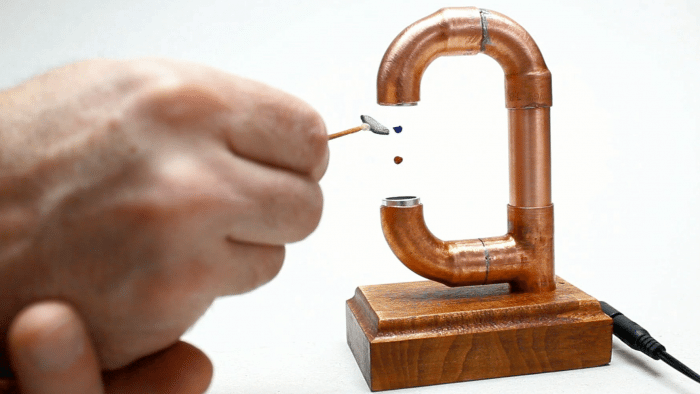We thought that making things levitate in mid-air by the power of sound was a little bit more like magic, or at least required fancy equipment. It turns out that you can do it yourself easily enough with parts that any decent hacker’s closet should have in abundance: a motor-driver IC, two ultrasonic distance pingers, and a microcontroller. This article shows you how (translated here, scroll down).
But aside from a few clever tricks, there’s not that much to show. The two HC-SR04 ultrasonic distance sensors are standard fare, and are just being used as a cheap source of 40 kHz transducers. The circuit uses a microcontroller, but any source of 40 kHz square waves should suffice. Those of you who could do that with a 555 (or a Raspberry Pi), this one’s for you! A stepper motor driver bumps up the voltage applied to the transducers, but you could use plain-vanilla transistors as well.
It’s all the little details that count, however. You need to position the two ultrasonic drivers fairly precisely to create a standing wave, and while you can start at 8.25 mm and trial-and-error it, the article demonstrates using an oscilloscope to align the capsules by driving one and reading the signal out of the other and tweaking them until they’re in phase. Clever!
The author also takes the ultrasonic-transparent grille from one of the unused receivers and uses it as a spoon to help position the styrofoam bits in the sound waves. We always wondered how you’d do that!
It turns out that it’s easy to make a DIY ultrasonic levitation desk toy, and none of the parts are expensive or critical. The missing ingredient is just the gumption to try it, and now we have that, too.
As cool as they are, the HC-SR04 modules aren’t perfect for all distance sensing applications. Here’s everything you need to know about them, including hacks to make them work up-close. And since HC-SR04 sensors come cheapest in ten-packs, you’ll be wondering what you’re going to do with the other eight. That problem has apparently also been solved.
















Wow, need to try this!
It’s almost unbelievable that it can still work at such low ultrasounds power.
O.o
What?
I couldn’t hear anything…
Kidding aside, this should be too far into the ultrasonic to damage your hearing. I also wouldn’t be suprised if it’s lower powered than some earbuds.
Nice, ha ha.
Well, using square waves will generate some significant harmonics. Turn this on in the same room and I guarantee you’ll never be able to hear 120Khz or 200Khz afterwards.
Since these work by driving the air to the point of non-linearity, someone should make two, perhaps cross them so the small area over which this is true is shared, and then drive one with a *modulated* carrier – the air itself will detect the signal and give audible sound. If one is just mistuned a little you’ll get the beat note. I’ve done this in the past in the attempt to make a “virtual woofer”, and others have also made “invisible speakers” this way.
It doesn’t work well at size as producing these kinds of sound pressure levels isn’t easy, especially since absorption/loss goes up as the square of frequency…
Still fun, though.
This sounds really interesting. Would you explain a little bit more?
A product that did that was sold under the name “Hypersonic Sound”. The speakers seem to be pretty expensive on the secondary market, costing a couple hundred bucks (apiece) Wikipedia has a nice article on the concept and implementations: https://en.wikipedia.org/wiki/Sound_from_ultrasound
There was also a kickstarter from someone who was trying to set up a kit where you could build a hypersonic speaker. I think it got funded, but I’m not sure what happened to it (I’m not a backer.)
The Kickstarter shipped. It worked. Sounds a little tinny, but cool demo.
There are many products out using this idea already.
Why would you have to experiment with the spacing? That sounds like a pain in the ass. Couldn’t you just vary the frequency until resonance is achieved?
Sid Dabster, I too was thinking that, as a first guess some kind off PLL to control.